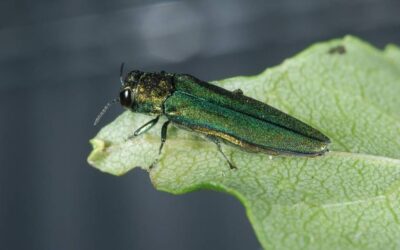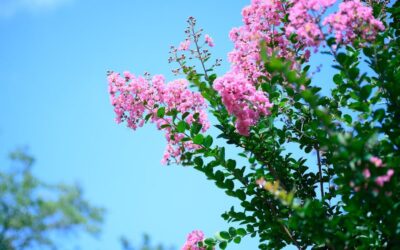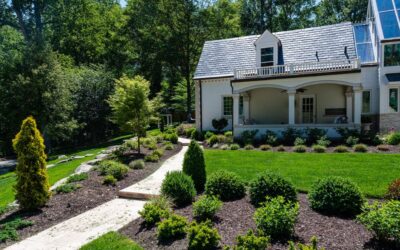Blog Topics
As temperatures warm in spring, a tiny, destructive pest emerges along with the new leaves on trees and shrubs. It’s the ambrosia beetle. And although its name may sound innocuous, the ambrosia beetle kills thousands of trees throughout Northern Virginia every year.
In this article, we cover the facts about this devastating pest, including:
- The types of ambrosia beetles found in Northern Virginia
- How they kill trees
- Signs of an ambrosia beetle attack
- When they’re active
- Prevention options
- Treatment options
What is an ambrosia beetle?
Ambrosia beetles are a group of bark beetles classified in the weevil family (Curculionidae). There are many species of native ambrosia beetles in Northern Virginia. While they do attack trees, they usually only attack weakened trees and aren’t generally considered to be a major landscape pest. Instead, it’s the non-native invasive species of ambrosia beetle that do most of the damage to trees in our area, including attacking apparently healthy trees.
In Northern Virginia, the major pest species we have to worry about is the granulate ambrosia beetle (Xylosandrus crassiusculus), which is commonly found in southeastern states. The black stem borer (Xylosandrus germanus, another species of ambrosia beetle) is more common in northeastern states, although it has spread to the south, southeast, and Pacific northwest. Unfortunately, because Virginia is at the intersection of the areas where these invasive pests are found, we often have to deal with both of them.
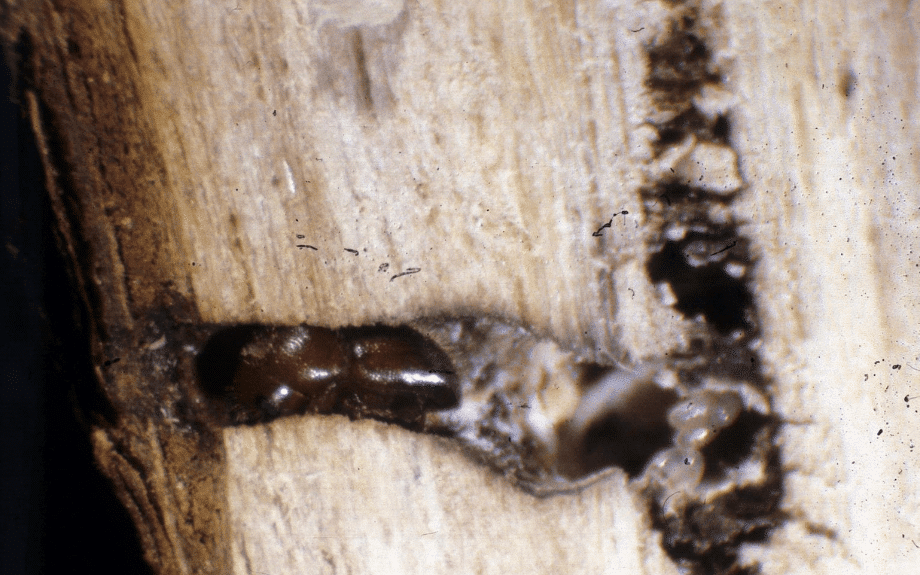
A granulate ambrosia beetle (Xylosandrus crassiusculus) navigates through wood A granulate ambrosia beetle (Xylosandrus crassiusculus) in wood. Lacy L. Hyche, Auburn University, Bugwood.org
How do the beetles kill trees?
The beetles bore or tunnel into wood to lay eggs. In the process, they deposit their own cultivated fungi in the tunnels they’ve excavated. This fungus provides food for their larvae to eat until they emerge as adults.
Although the beetles create extensive tunnels, that’s not what kills the tree. Instead, it’s the fungus that kills it.
The fungi supplied by the ambrosia beetle are fatal to the trees they infect. The fungi damage and clog the tree’s vascular system (phloem) that takes up water and nutrients, eventually killing the tree.
When are ambrosia beetles active in Northern Virginia?
Ambrosia beetles are active from spring through fall, with peak activity usually happening in mid-to late-April.
Adults overwinter in leaf litter or within the galleries they’ve tunneled into the host tree. The females emerge with spring’s warming weather and fly to find a suitable host in which to lay their eggs. You’ll see them start flying when we get three or more consecutive days with temperatures above 65F (this is usually also when trees start to leaf out). But if colder temperatures return, they’ll disappear until it warms up again.
What do ambrosia beetles look like?
The beetles themselves are very small (¼” – ½”), dark brown, and not showy. The holes they bore are small and may be hard to see.
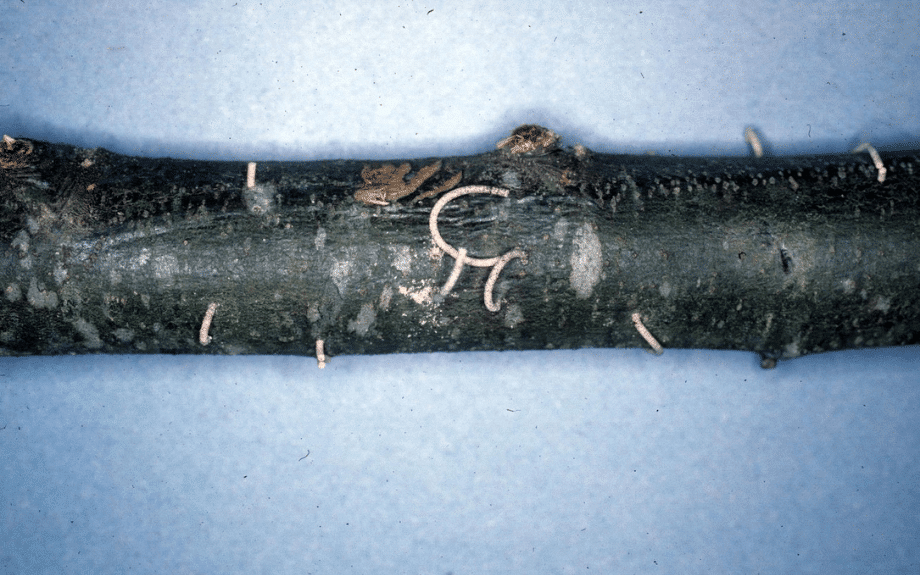
The toothpick-like frass sticking out from this tree is caused by ambrosia beetles, and is a sign of infestation. Lacy L. Hyche, Auburn University, Bugwood.org
How can I tell if my trees have been attacked by ambrosia beetles?
The most common way to identify ambrosia beetles is by the piles or tubes of “frass,” or waste material, that the beetles push out of the tree. Frass tubes look a little like toothpicks sticking out of bark and frass piles look like leaking sawdust.
Frass tubes are much easier to spot than the tiny beetles or the holes they create but are quickly blown away by wind and washed off by rain or irrigation. If you suspect your trees are infested with ambrosia beetles, check for frass toothpicks early in the morning on a calm, dry day.
Ambrosia beetle damage to trees is also identified by rapid crown wilting and die-back of twigs and branches. A stressed tree can die quickly during a period of hot weather, as water cannot reach the branches and leaves of its crown.
What trees do ambrosia beetles attack?
Ambrosia beetles are non-host specific and will attack almost any tree species, native or introduced. However, they seem to prefer broadleaved trees (rather than trees with needles). They’ve been found on more than 200 different plant species, including aspen, beech, cherry, Chinese elm, crape myrtle, dogwood, golden rain tree, hickory, magnolia, maple, mimosa, oak, peach, persimmon, Prunus, redbud, sweetgum, tulip, poplar, Styrax, and walnut. In Virginia, ambrosia beetles have also been reported on grapevines.
Generally, ambrosia beetles attack trees that are under stress from:
- Heat
- Drought
- Freeze damage
- Nutrient deficiencies
- Construction damage or soil compaction
- Other diseases or pests
Flooded trees or trees planted in wet areas are also more prone to attacks.
Stressed and damaged trees release ethanol, which attracts ambrosia beetles. In fact, it’s the key component in traps used to capture and track the number of beetles in a given area.
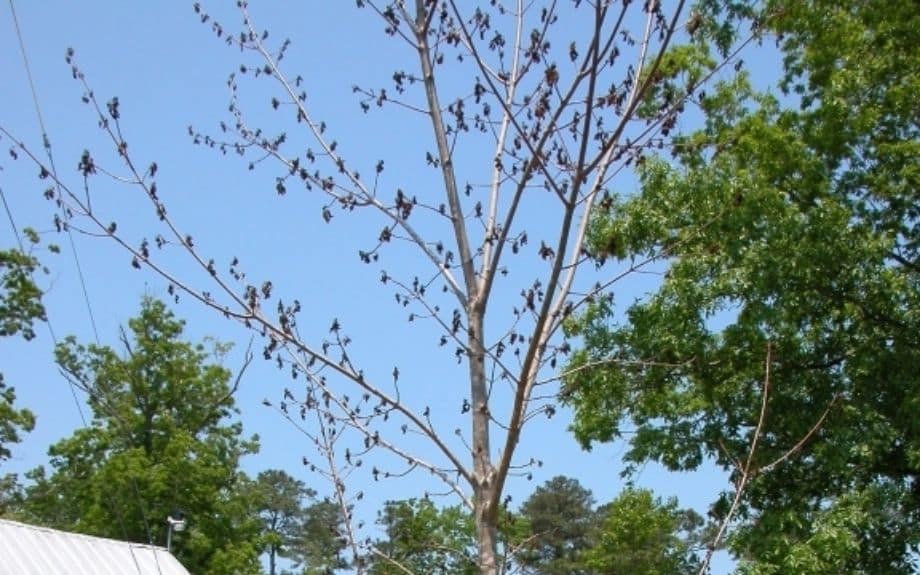
Granulate ambrosia beetle (Xylosandrus crassiusculus) damage has led to die-back on the canopy of this sugar maple tree. Laura Lazarus, North Carolina Division of Forest Resources, Bugwood.org
Do they attack healthy trees?
Ambrosia beetles, particularly the non-native species, will also attack healthy trees. However, they are less successful in boring into healthy trees because of pressure from the trees’ vascular system.
A tree’s vascular system, or its “plumbing,” pulls water up from tree roots to the leaves in the tree’s crown. It has to maintain enough internal pressure for water to move vertically. As with pressurized irrigation or plumbing lines, a hole punched in the tree’s “pipes” will result in water spraying out. Similarly, when a beetle bores into the bark, the pressurized vascular system will push it back out as the wound weeps.
Why are they called “ambrosia beetles”?
The name “ambrosia” was given to these beetles because of their direct reliance on the fungi they cultivate to feed their larvae. The Greek gods of ancient myth survived on their single “food of immortality,” which was called ambrosia.
How can I get rid of ambrosia beetles?
Since the beetles do not feed on their host trees, there are no systemic pesticide treatments for them.
It’s possible to apply pyrethroid sprays that repel boring beetles to the tree bark. The sprays will need to be reapplied every two or three weeks to maintain repellent strength.
However, these sprays need to be carefully timed to coincide with the beginning of the ambrosia beetles’ “attack period”. If you start spraying too early, you’ll waste your time and money; too late, and your trees will already have been infected. Unfortunately, the timing of their emergence is so unpredictable and weather-dependent, making timing trunk sprays rather difficult.
If I can’t control them, can I prevent ambrosia beetle attacks?
For your trees, the best treatment against ambrosia beetles is prevention. Keeping your trees healthy is their best defense against beetles. Here are some ways to do that:
- Water trees regularly. Give your trees enough irrigation water, especially during hot spells or heat waves.
- Maintain good soil fertility. Make sure your soil has sufficient nutrients to support your trees. Soil testing for Northern Virginia homeowners is available through the Virginia Tech Soil Testing Lab here.
- Place mulch around trees. Mulching around a tree’s critical root zone is always a good idea. Mulch reduces water evaporation from the soil, suppresses competing weeds, and regulates soil temperatures.
- Remove any trees with ambrosia beetle damage to reduce beetle populations and spread.
Ambrosia beetles also target milled lumber and stored firewood, so:
- De-bark your logs
- Don’t store milled, cut, or chopped wood where ambrosia beetles can infest it
- DON’T bring your own firewood into state forests!
Need a Hand?
If you have valuable landscape trees that you want to protect from ambrosia beetles, give us a call. We’ll inspect your trees, recommend ways to ensure that they stay healthy, and determine whether a preventive bark spray is a good option for your tree(s).
Trees that have been attacked by ambrosia beetles will start to decline and die. These should be removed quickly to help prevent the spread of these destructive pests. That’s a job best left to tree service professionals who can do the job safely and with minimal risk of distributing the beetles to uninfected plants.
Give Us a Call at 703-402-9366
If you'd like help with your trees or landscape, have any questions, or would like to schedule an appointment with one of our Certified Arborists, please give us a call. We'd love to hear from you!

